NCERT Class 10 Maths Chapter 5: Arithmetic ProgressionsExercise 5.11. In which of the following situations, does the list of numbers involved make an arithmetic progression, and why?
Solution I. Let the taxi fare for n km be tn. It is given that, t1 = 15 t2 = 15 + 8 t3 = 23 + 8 t4 = 31 + 8 Since, t4 - t3 = t3 - t2 = t2 - t1 Hence, the given situation forms an Arithmetic Progression. II. Let tn be the amount of air left after vacuum pump is used n times. Let t1 = x t2 = x - ¼(x) t3 = ¾(x) - ¼(¾(x)) Since, t3 - t2 ≠ t2 - t1 Hence, the given situation does not form an Arithmetic Progression. III. Let the cost of digging for n metre be tn. It is given that, t1 = 150 t2 = 150 + 50 t3 = 200 + 50 t4 = 250 + 50 Since, t4 - t3 = t3 - t2 = t2 - t1 Hence, the given situation forms an Arithmetic Progression. IV. Let the amount of money for n years be tn. It is given that, t1 = 10000 t2 = 10000 + 10000 × 8/100 t3 = 10800 + 10800 × 8/100 t4 = 11664 + 11664 × 8/100 Since, t4 - t3 ≠ t3 - t2 ≠ t2 - t1 Hence, the given situation does not form an Arithmetic Progression. 2. Write first four terms of the AP, when the first term a and the common difference d are given as follows:
Solution I. a = 10 a2 = 10 + 10 = 20 a3 = 20 + 10 = 30 a4 = 30 + 10 = 40 The first four terms are 10, 20, 30 and 40. II. a = -2 a2 = -2 + 0 = -2 a3 = -2 + 0 = -2 a4 = -2 + 0 = -2 The first four terms are -2, -2, -2 and -2. III. a = 4 a2 = 4 - 3 = 1 a3 = 1 - 3 = -2 a4 = -2 - 3 = -5 The first four terms are 4, 1, -2 and -5. IV. a = -1 a2 = -1 + 1/2 = -1/2 a3 = -1/2 + 1/2 = 0 a4 = 0 + 1/2 = 1/2 The first four terms are -1, -1/2, 0 and 1/2. V. a = -1.25 a2 = -1.25 - 0.25 = -1.5 a3 = -1.5 - 0.25 = -1.75 a4 = -1.75 - 0.25 = -2.00 The first four terms are -1.25, -1.5, -1.75 and -2. 3. For the following APs, write the first term and the common difference:
Solution I. First term = a = 3 d = a2 - a = 1 - 3 = -2 II. First term = a = -5 d = a2 - a = -5 - (-1) = -4 III. First term = a = 1/3 d = a2 - a = 5/3 - 1/3 = 4/3 IV. First term = a = 0.6 d = a2 - a = 1.7 - 0.6 = 1.1 4. Which of the following are APs? If they form an AP, find the common difference d and write three more terms.
Solution I. t2 - t1 = 4 - 2 = 2 t3 - t2 = 8 - 4 = 4 Since, t3 - t2 ≠ t2 - t1 Hence, it is not an Arithmetic Progression. II. t2 - t1 = 5/2 - 2 = 1/2 t3 - t2 = 3 - 5/2 = 1/2 Since, t3 - t2= t2 - t1 Hence, it is an Arithmetic Progression. First term = a = 2 Common difference = d = ½ Four more terms would be a5 = 7/2 + ½ = 4 a6 = 4 + ½ = 9/2 a7 = 9/2 + ½ = 5 a8 = 5 + ½ = 11/2 III. t2 - t1 = -3.2 - (-1.2) = -2 t3 - t2 = -5.2 - (-3.2) = -2 Since, t3 - t2= t2 - t1 Hence, it is an Arithmetic Progression. First term = a = -1.2 Common difference = d = -2 Four more terms would be a5 = -7.2 - 2 = -9.2 a6 = -9.2 - 2 = -11.2 a7 = -11.2 - 2 = -13.2 a8 = -13.2 - 2 = -15.2 IV. t2 - t1 = -6 - (-10) = 4 t3 - t2 = -2 - (-6) = 4 Since, t3 - t2= t2 - t1 Hence, it is an Arithmetic Progression. First term = a = -10 Common difference = d = 4 Four more terms would be a5 = 2 + 4 = 6 a6 = 6 + 4 = 10 a7 = 10 + 4 = 14 a8 = 14 + 4 = 18 V. t2 - t1 = 3 + √2 - 3 = √2 t3 - t2 = 3 + 2√2 - (3 + √2) = √2 Since, t3 - t2= t2 - t1 Hence, it is an Arithmetic Progression. First term = a = 3 Common difference = d = √2 Four more terms would be a5 = 3 + 3√2 + √2 = 3 + 4√2 a6 = 3 + 4√2 + √2 = 3 + 5√2 a7 = 3 + 5√2 + √2 = 3 + 6√2 a8 = 3 + 6√2 + √2 = 3 + 7√2 VI. t2 - t1 = 0.22 - 0.2 = 0.02 t3 - t2 = 0.222 - 0.22 = 0.002 Since, t3 - t2 ≠ t2 - t1 Hence, it is not an Arithmetic Progression. VII. t2 - t1 = -4 - 0 = -4 t3 - t2 = -8 - (-4) = -4 Since, t3 - t2= t2 - t1 Hence, it is an Arithmetic Progression. First term = a = 0 Common difference = d = -4 Four more terms would be a5 = -12 - 4 = -16 a6 = -16 - 4 = -20 a7 = -20 - 4 = -24 a8 = -24 - 4 = -28 VIII. t2 - t1 = -1/2 - (-1/2) = 0 t3 - t2 = -1/2 - (-1/2) = 0 Since, t3 - t2= t2 - t1 Hence, it is an Arithmetic Progression. First term = a = -1/2 Common difference = d = 0 Four more terms would be a5 = -1/2 + 0 = -1/2 a6 = -1/2 + 0 = -1/2 a7 = -1/2 + 0 = -1/2 a8 = -1/2 + 0 = -1/2 IX. t2 - t1 = 3 - 1 = 2 t3 - t2 = 9 - 3 = 6 Since, t3 - t2 ≠ t2 - t1 Hence, it is not an Arithmetic Progression. X. t2 - t1 = 2a - a = a t3 - t2 = 3a - 2a = a Since, t3 - t2= t2 - t1 Hence, it is an Arithmetic Progression. First term = a1 = a Common difference = d = a Four more terms would be a5 = 4a + a = 5a a6 = 5a + a = 6a a7 = 6a + a = 7a a8 = 7a + a = 8a XI. t2 - t1 = a2 - a = a(a - 1) t3 - t2 = a3 - a2 = a2 (a - 1) Since, t3 - t2 ≠ t2 - t1 Hence, it is not an Arithmetic Progression. XII. t2 - t1 = √8 - √2 = √2 t3 - t2 = √18 - √8= √2 Since, t3 - t2= t2 - t1 Hence, it is an Arithmetic Progression. First term = a = √2 Common difference = d = √2 Four more terms would be a5 = √32 + √2 = √50 a6 = √50 + √2 = √72 a7 = √72 + √2 = √98 a8 = √98 + √2 = √128 XIII. t2 - t1 = √6 - √3 t3 - t2 = √9 - √6 Since, t3 - t2 ≠ t2 - t1 Hence, it is not an Arithmetic Progression. XIV. t2 - t1 = 32 - 12 = 8 t3 - t2 = 52 - 32 = 16 Since, t3 - t2 ≠ t2 - t1 Hence, it is not an Arithmetic Progression. XV. t2 - t1 = 52 - 12 = 24 t3 - t2 = 72 - 52 = 24 Since, t3 - t2= t2 - t1 Hence, it is an Arithmetic Progression. First term = a1 = 12 Common difference = d = 24 Four more terms would be a5 = 73 + 24 = 97 a6 = 97 + 24 = 121 = 112 a7 = 121 + 24 = 145 a8 = 145 + 24 = 169 = 132 Exercise 5.21. Fill in the blanks in the following table, given that a is the first term, d the common difference and an the nth term of the AP: 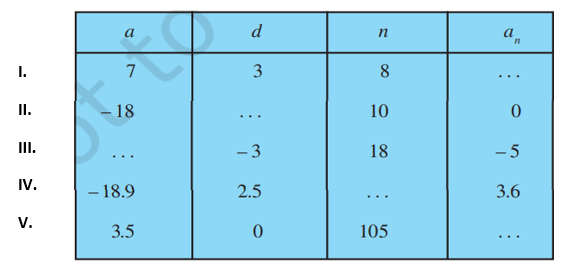
Solution I. an = a + (n - 1)d = 7 + 7(3) = 7 + 21 = 28 II. an = a + (n - 1)d 0 = -18 + 9d 18 = 9d d = 2 III. an = a + (n - 1)d -5 = a + (17)(-3) -5 = a - 51 46 = a IV. an = a + (n - 1)d 3.6 = -18.9 +(n - 1)2.5 22.5 = (n - 1)2.5 9 = n - 1 n = 10 V. an = a + (n - 1)d= 3.5 + 0 = 3.5 Hence, the completed table is: 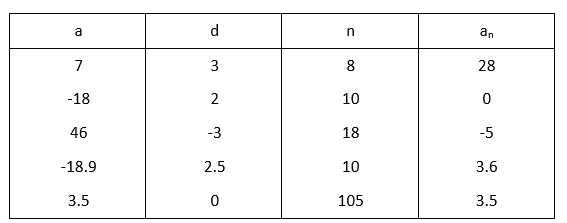
2. Choose the correct choice in the following and justify : 
Solution I. For the given AP, a = 10 and d = 7 - 10 = -3 a30 = a + (n - 1)d = 10 + 29(-3) = 10 - 87 = -77 Hence, (C) is the correct answer. II. For the given AP, a = -3 and d = -1/2 - (-3) = -1/2 + 3 = 5/2 a11 = a + (n - 1)d = -3 + 10(5/2) = -3 + 25 = 22 Hence, (B) is the correct answer. 3. In the following APs, find the missing terms in the boxes : 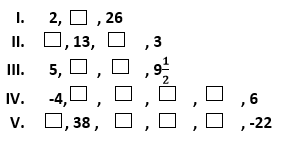
Solution I. a = 2 an = a + (n - 1)d a3 = 26 = 2 + 2d 24 = 2d d = 12 a2 = a + 12 = 2 + 12 = 14 II. a2 = 13, a4 = 3 a4 - a3 = a3 - a2 3 - a3 = a3 - 13 16 = 2a3 a3 = 8 d = a3 - a2 = 8 - 13 = -5 a = a2 - d = 13 - (-5) = 13 + 5 = 18 III. a = 5 a4 = an = a + (n - 1)d 19/2 = 5 + 3d 9/2 = 3d 3/2 = d a2 = a + d = 5 + 3/2 = 13/2 a3 = a + 2d = 5 + 2(3/2) = 5 + 3 = 8 IV. a = -4 a6 = 6 an = a + (n - 1)d a6 = -4 + 5d 6 = -4 + 5d 10 = 5d d = 2 a2 = a + d = -4 + 2 = -2 a3 = a + 2d = -4 + 2(2) = 0 a4 = a + 3d = -4 + 3(2) = 2 a5 = a + 4d = -4 + 4(2) = 4 V. a2 = 38 a6 = -22 an = a + (n - 1)d 38 = a + d … (I) -22 = a + 5d … (II) Subtract (I) from (II) -22 - 38 = a + 5d - (a + d) -60 = 4d -15 = d Using d = -15 in (I) 38 = a - 15 53 = a a3 = a + 2d = 53 + 2(-15) = 23 a4 = a + 3d = 53 - 3(15) = 8 a5 = a + 4d = 53 - 4(15) = -7 4. Which term of the AP : 3, 8, 13, 18, . . . ,is 78? Solution First term = a = 3 Common difference = d = 8 - 3 = 5 an = 78 an = a + (n - 1)d 78 = 3 + (n - 1)5 75 = (n - 1)5 15 = n - 1 n = 16 Hence, 78 is the 16th term of the given AP. 5. Find the number of terms in each of the following APs :
Solution I. First term = a = 7 Last term = l = 205 Common difference = d = 13 - 7 = 6 l = a + (n - 1)d 205 = 7 + (n - 1)6 198 = (n - 1)6 33 = n - 1 n = 34 Hence, the given AP has 34 terms. II. First term = a = 18 Last term = l = -47 Common difference = d = 31/2 - 18 = -5/2 l = a + (n - 1)d -47 = 18 + (n - 1)(-5/2) -65 = (1 - n)(5/2) -130 = (1 - n)5 -26 = 1 - n n = 27 Hence, the given AP has 27 terms. 6. Check whether - 150 is a term of the AP : 11, 8, 5, 2 . . . Solution Let us assume that -150 is a term of the given AP. First term = a = 11 Common Difference = 8 - 11 = -3 an = -150 an = a + (n - 1)d -150 = 11 + (n - 1)(-3) -161 = (n - 1)(-3) 161/3 + 1 = n 164/3 = n But this contradicts the fact that n is a natural number. The contradiction has arisen due to the wrong assumption that -150 is a term of the given AP. 7. Find the 31st term of an AP whose 11th term is 38 and the 16th term is 73. Solution a11 = 38 a16 = 73 an = a + (n - 1)d 38 = a + 10d … (I) 73 = a + 15d … (II) Subtract (I) from (II) 73 - 38 = a + 15d - (a + 10d) 35 = 5d 7 = d Using d = 7 in (I) 38 = a + 70 a = -32 a31 = -32 + 30(7) = -32 + 210 a31 = 178 8. An AP consists of 50 terms of which 3rd term is 12 and the last term is 106. Find the 29th term. Solution a50 = l = 106 a3 = 12 an = a + (n - 1)d 106 = a + 49d … (I) 12 = a + 2d … (II) Subtract (II) from (I) 106 - 12 = a + 49d - (a + 2d) 94 = 47d 2 = d Using d = 2 in (II) 12 = a + 4 a = 8 a29 = 8 + 28(2) = 8 + 56 a29 = 64 9. If the 3rd and the 9th terms of an AP are 4 and - 8 respectively, which term of this AP is zero? Solution a9 = -8 a3 = 4 an = a + (n - 1)d -8 = a + 8d … (I) 4 = a + 2d … (II) Subtract (II) from (I) -8 - 4 = a + 8d - (a + 2d) -12 = 6d -2 = d Using d = -2 in (II) 4 = a - 4 a = 8 Let the xth term be 0. ax = a + (x - 1)d 0 = 8 + (x - 1)(-2) -8 = (x - 1)(-2) 4 = x - 1 x = 5 Hence, the 5th term of the AP is 0. 10. The 17th term of an AP exceeds its 10th term by 7. Find the common difference. Solution an = a + (n - 1)d a17 - a10 = 7 a + 16d - (a + 9d) = 7 7d = 7 d = 1 Hence, the common difference for the given AP is 1. 11. Which term of the AP : 3, 15, 27, 39, . . . will be 132 more than its 54th term? Solution Let the required term be an. First term = a = 3 Common difference = d = 15 - 3 = 12 an = a54 + 132 a + (n - 1)d = a + 53d + 132 (n - 1)12 = 53(12) + 132 
(n - 1) = 53 + 11 n - 1 = 64 n = 65 Hence, the 65th term of the given AP will be 132 more than its 54th term. 12. Two APs have the same common difference. The difference between their 100th terms is 100, what is the difference between their 1000th terms? Solution A100 - a100 = 100 A + 99d - (a + 99d) = 100 A - a = 100 A1000 - a1000 = A + 999d - (a + 999d) = A - a = 100 Hence, the difference in their 1000th terms is 100. 13. How many three-digit numbers are divisible by 7? Solution The list of 3 digit numbers that are divisible by 7 is 105, 112, …, 994 a = 105 d = 7 Last term = a + (n - 1)d 994 = 105 + (n - 1)7 889 = (n - 1)7 127 = n - 1 128 = n Hence, there are 128 three digit numbers that are divisible by 7. 14. How many multiples of 4 lie between 10 and 250? Solution Multiples of 4 between 10 and 250 are 12, 16, 20, …, 248 a = 12 d = 4 Last term = a + (n - 1)d 248 = 12 + (n - 1)4 236 = (n - 1)4 59 = n - 1 n = 60 Hence, there are 60 multiples of 4 between 10 and 250. 15. For what value of n, are the nth terms of two APs: 63, 65, 67, . . . and 3, 10, 17, . . . equal? Solution We need to find n such that An = an A = 63 d1 = 65 - 63 = 2 a = 3 d2 = 10 - 3 = 7 An = an A + (n - 1)d1 = a + (n - 1)d2 63 + (n - 1)2 = 3 + (n - 1)7 60 + 2n - 2 = 7n - 7 65 = 5n n = 13 Hence, the 13th terms of the given APs are equal. 16. Determine the AP whose third term is 16 and the 7th term exceeds the 5th term by 12. Solution a3 = 16 a7 - a5 = 12 a + 6d - (a + 4d) = 12 2d = 12 d = 6 a3 = 16 a + 2d = 16 a + 2(6) = 16 a = 16 - 12 a = 4 a2 = a + d = 4 + 6 = 10 Hence, the required AP is 4, 10, 16, … 17. Find the 20th term from the last term of the AP : 3, 8, 13, . . ., 253. Solution Reverse the given AP: 253, 248, …, 13, 8, 3 an = a + (n - 1)d a = 253 d = 248 - 253 = -5 a20 = a + 19d = 253 + 19(-5) = 253 - 95 = 158 Hence, the 20th term from the last will be 158. 18. The sum of the 4th and 8th terms of an AP is 24 and the sum of the 6th and 10th terms is 44. Find the first three terms of the AP. Solution a4 + a8 = 24 a6 + a10 = 44 a + 3d + a + 7d = 24 2a + 10d = 24 2 (a + 5d) = 24 a + 5d = 12 = a6 a + 5d + a10 = 44 a10 + 12 = 44 a10 = 32 Subtract a6 from a10 a10 - a6 = 32 - 12 a + 9d - (a + 5d) = 20 4d = 20 d = 5 Use d = 5 in a + 5d = 12 a + 5(5) = 12 a + 25 = 12 a = -13 Therefore, first term = -13 and common difference = 5. Hence, the first 3 terms will be: a1 = -13 a2 = a + d = -13 + 5 = -8 a3 = a + 2d = -13 + 2(5) = -13 + 10 = -3 19. Subba Rao started work in 1995 at an annual salary of Rs 5000 and received an increment of Rs 200 each year. In which year did his income reach Rs 7000? Solution Subba Rao's salary each year can be represented as an AP: 5000, 5200, 5400, . . . Salary in 1995 = First term = a = 5000 Increment each year = Common difference = d = 200 an = a + (n - 1)d an = 7000 7000 = 5000 + (n - 1)200 2000 = (n - 1)200 10 = n - 1 n = 11 The 11th term in the AP is 7000. If the first term represents year 1995, then 11th term represents 1995 + 10 = 2005. Hence, Subba Rao's salary reached Rs 7000 in the year 2005. 20. Ramkali saved Rs 5 in the first week of a year and then increased her weekly savings by Rs 1.75. If in the nth week, her weekly savings become Rs 20.75, find n. Solution Ramkali's savings each week can be represented as an AP: 5, 6.75, 8.5, . . . Starting saving = First term = a = 5 Savings increment per week = Common difference = d = 1.75 an = a + (n - 1)d an = 20.75 20.75 = 5 + (n - 1)(1.75) 15.75 = (n - 1)(1.75) 9 = n - 1 10 = n The 10th term of the AP is 20.75. Hence, Ramkali's savings became Rs 20.75 in the 10th week. Exercise 5.31. Find the sum of the following APs:
Solution 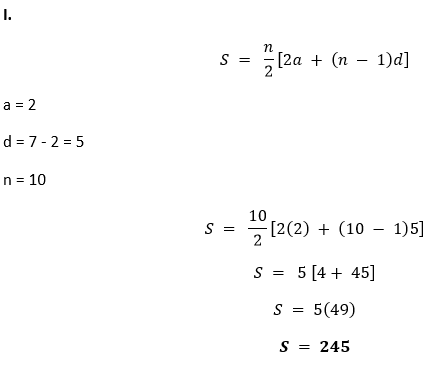
Hence, the sum of the given AP is 245. 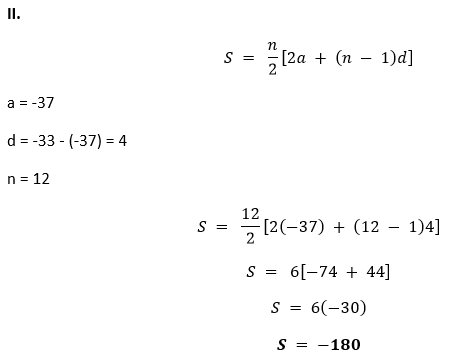
Hence, the sum of the given AP is -180. 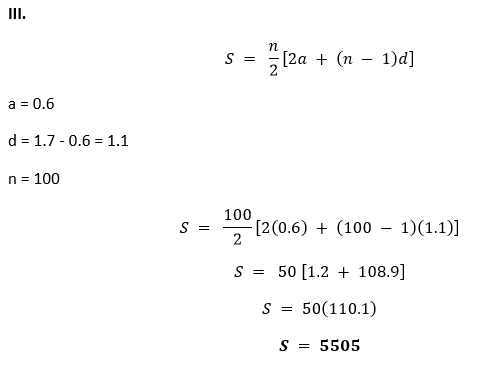
Hence, the sum of the given AP is 5505. 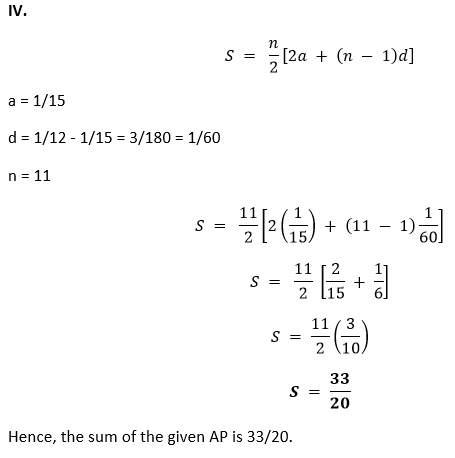
2. Find the sums given below :
Solution I. = a + (n - 1)d a = 7, d = 21/2 - 7 = 7/2, an = 84 84 = 7 + (n - 1)7/2 77 = (n - 1)7/2 22 = n - 1 n = 23 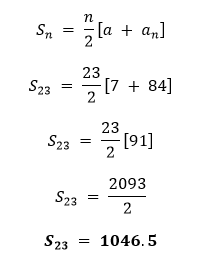
Hence, the sum of the given AP is 1046.5 II. an = a + (n - 1)d a = 34, d = 32 - 34 = -2, an = 10 10 = 34 + (n - 1)(-2) -24 = (n - 1)(-2) 12 = n - 1 n = 13 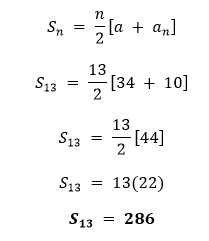
Hence, the sum of the given AP is 286. III. an = a + (n - 1)d a = -5, d = -8 - (-5) = -3, an = -230 -230 = -5 + (n - 1)(-3) -225 = (n - 1)(-3) 75 = n - 1 n = 76 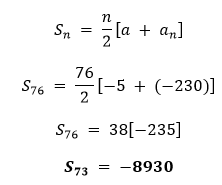
Hence, the sum of the given AP is -8930. 3. In an AP:
Solution an = a + (n - 1)d 50 = 5 + (n - 1)3 45 = (n - 1)3 15 = n - 1 n = 16 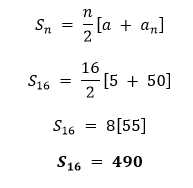
Hence, n = 16 and Sn = 490. II. an = a + (n - 1)d a13 = 7 + (13 - 1)d 35 = 7 + 12d 28 = 12d 7/3 = d 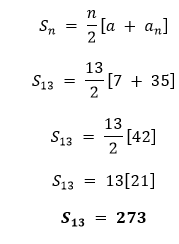
Hence, d = 7/3 and S13 = 273. III. an = a + (n - 1)d a12 =a + (12 - 1)3 37 = a + 33 a = 4 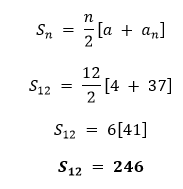
Hence, a = 4 and S12 = 490. IV. an = a + (n - 1)d a3 = a + (3 - 1)d 15 = a + 2d … Equation (I) 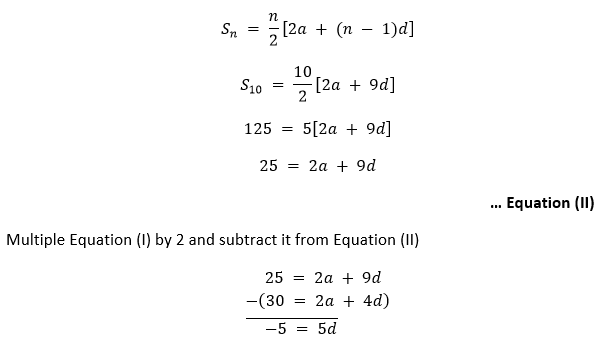
d = -1 Using d = -1 in Equation (I) 15 = a + 2(-1) 15 = a - 2 17 = a a10 = a + (10 - 1)d = 17 + 9(-1) = 17 - 9 = 8 a10 = 8 Hence, d = -1 and a10 = 8. V. 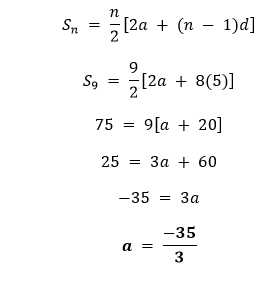
a9 = a + (9 - 1)d a9 = -35/3 + 8(5) a9 = -35/3 + 40 a9 = 85/3 Hence, a = -35/3 and a9 = 85/3. VI. 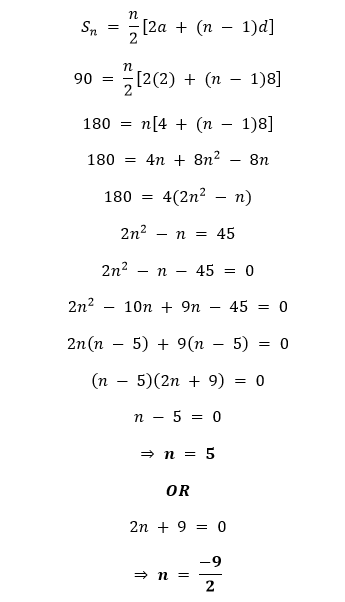
But n has to be a positive integer, so n = -9/2 is rejected. Therefore, n = 5. a5 = a + (5 - 1)d = 2 + 4(8) = 2 + 32 = 34 a5 = 34 Hence, n = 5 and an = 34. VII. 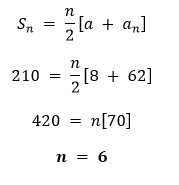
an = a + (n - 1)d a6 = 8 + (6 - 1)d 62 = 8 + 5d 54 = 5d d = 54/5 Hence, n = 6 and d = 54/5. VIII. an = a + (n - 1)d 4 = a + (n - 1)2 4 = a + 2n - 2 6 = a + 2n a = 6 - 2n 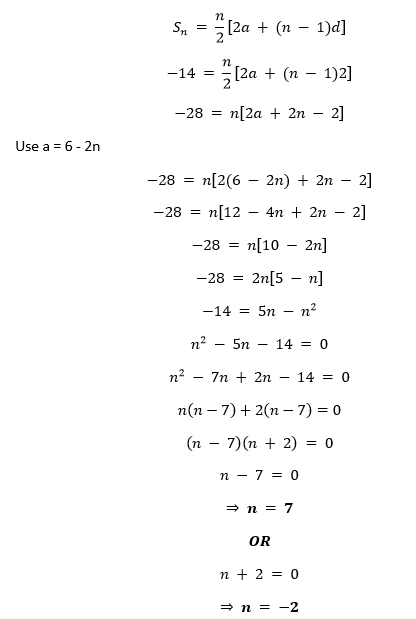
But n has to be a positive integer, so n = -2 is rejected. Therefore, n = 7. a = 6 - 2n = 6 - 2(7) = 6 - 14 a = -8 Hence, n = 7 and a = -8. IX. 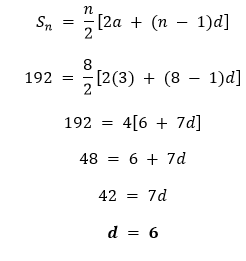
Hence, d = 6. X. 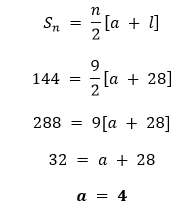
Hence, a = 4. 4.How many terms of the AP : 9, 17, 25, . . . must be taken to give a sum of 636? Solution First term = a = 9 Common difference = 17 - 9 = 8 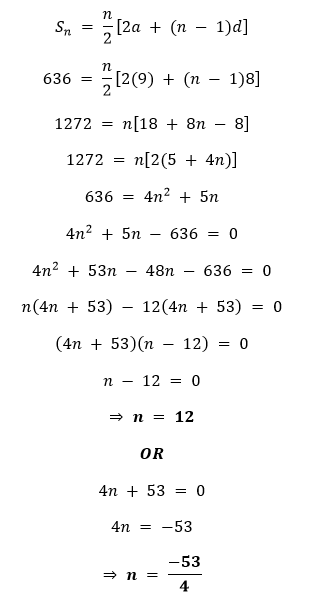
But, n has to be a positive integer, so n = -53/4 is rejected. Therefore, n = 12. Hence, 12 terms of the given AP must be taken to get a sum of 636. 5. The first term of an AP is 5, the last term is 45 and the sum is 400. Find the number of terms and the common difference. Solution First term = a = 5 Last term = l = 45 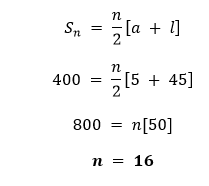
l = a16 = 45 an = a + (n - 1)d a16 = 5 + (16 - 1)d 45 = 5 + 15d 40 = 15d d = 8/3 Hence, the number of terms in the AP is 16 and the common difference is 8/3. 6. The first and the last terms of an AP are 17 and 350 respectively. If the common difference is 9, how many terms are there and what is their sum? Solution First term = a = 17 Last term = l = an = 350 Common difference = d = 9 an = a + (n - 1)d 350 = 17 + (n - 1)9 333 = (n - 1)9 37 = n - 1 n = 38 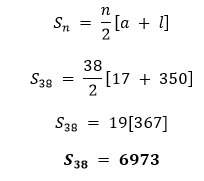
Hence, the AP consists of 38 terms, and the sum of the AP is 6973. 7. Find the sum of first 22 terms of an AP in which d = 7 and 22nd term is 149. Solution a22 = 149 Common difference = d = 7 an = a + (n - 1)d a22 = a + (22 - 1)7 149 = a + 21(7) 149 = a + 147 a = 2 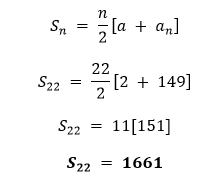
Hence, the sum of the first 22 terms of the given AP is 1661. 8. Find the sum of first 51 terms of an AP whose second and third terms are 14 and 18 respectively. Solution Common difference = d = a3 - a2 d = 18 - 14 = 4 an = a + (n - 1)d a2 = a + d 14 = a + 4 a = 10 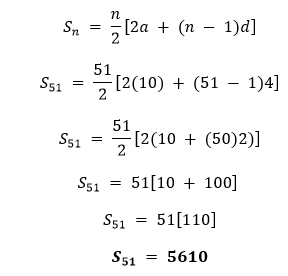
9. If the sum of first 7 terms of an AP is 49 and that of 17 terms is 289, find the sum of first n terms. Solution 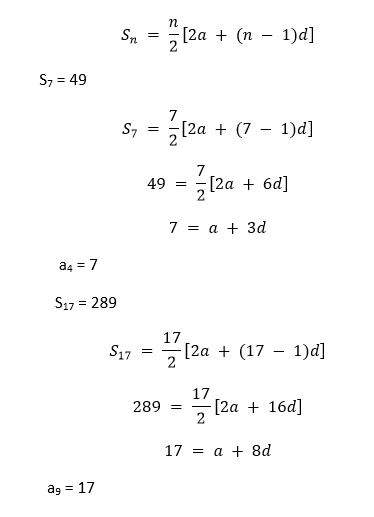
a9 - a4 = a + 8d - (a + 3d) 17 - 7 = a + 8d - a - 3d 10 = 5d d = 2 Using d = 2 in a + 3d = 7 a + 3(2) = 7 a + 6 = 7 a = 1 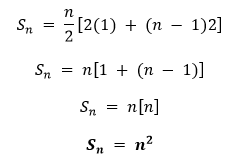
Hence, the sum of first n terms of the given AP is n2. 10. how that a1, a2 , . . ., an , . . . form an AP where an is defined as below :
Also find the sum of the first 15 terms in each case. Solution I. an = 3 + 4n a1 = 3 + 4(1) = 3 + 4 = 7 a2 = 3 + 4(2) = 3 + 8 = 11 a3 = 3 + 4(3) = 3 + 12 = 15 a2 - a1 = 11 - 7 = 4 a3 - a2 = 15 - 11 = 4 Since, a2 - a1 = a3 - a2, therefore the given sequence is an AP with common difference = d = 4. a15 = 3 + 4(15) = 3 + 60 = 63 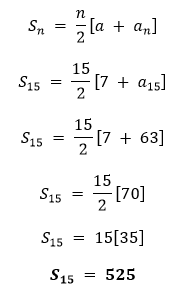
Hence, the sum of the first 15 terms of the given AP is 525. II. an = 9 - 5n a1 = 9 - 5(1) = 9 - 5 = 4 a2 = 9 - 5(2) = 9 - 10 = -1 a3 = 9 - 5(3) = 9 - 15 = -6 a2 - a1 = -1 - 4 = -5 a3 - a2 = -6 - (-1) = -5 Since, a2 - a1 = a3 - a2, therefore the given sequence is an AP with common difference = d = -5. a15 = 9 - 5(15) = 9 - 75 = -66 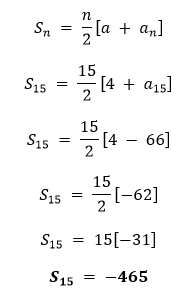
Hence, the sum of the first 15 terms of the given AP is -465. 11. If the sum of the first n terms of an AP is 4n - n2 , what is the first term (that is S1 )? What is the sum of first two terms? What is the second term? Similarly, find the 3rd, the 10th and the nth terms. Solution It is given that Sn = 4n - n2 First term = a = S1 S1 = 4(1) - (1)2 = 4 - 1 S1 = a = 3 Sum of the first two terms = S2 S2 = 4(2) - (2)2 = 8 - 4 S2 = 4 S2 = a + a2 4 = 3 + a2 a2 = 1 Therefore, the second term is 1. S3 = 4(3) - (3)2 = 12 - 9 = 3 S3 = S2 + a3 3 = 4 + a3 a3 = -1 Therefore, the third term is -1. S9 = 4(9) - (9)2 = 36 - 81 = -45 S10 = 4(10) - (10)2 = 40 - 100 = -60 S10 = S9 + a10 -60 = -45 + a10 a10 = -15 Therefore, the 10th term is -15. Similarly, Sn = Sn - 1 + an an = Sn - Sn - 1 an = 4n - n2 - [4(n - 1) - (n - 1)2] an = 4n - n2 - [4n - 4 - (n2 + 1 - 2n)] an = 4n - n2 - (6n - 5 - n2) an = 5 - 2n Therefore, the nth term is 5 - 2n. 12. Find the sum of the first 40 positive integers divisible by 6. Solution The list of first 40 positive integers divisible by 6 can be represented as an AP: 6 × 1, 6 × 2, 6 × 3, … … , 6 × 40 6, 12, 18, … … , 240 First term = a = 6 Common difference = d = 6 a40 = 240 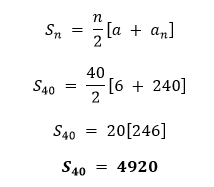
Hence, the sum of first 40 positive integers divisible by 6 is 4920. 13. Find the sum of the first 15 multiples of 8. Solution The list of first 15 multiples of 8 forms an AP: 8 × 1, 8 × 2, 8 × 3, … … , 8 × 15 8, 16, 24, … … , 120 First term = a = 8 Common difference = d = 8 a15 = 120 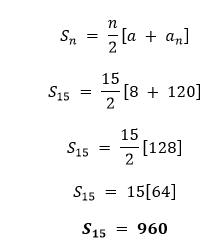
Hence, the sum of first 15 multiples of 8 is 4920. 14. Find the sum of the odd numbers between 0 and 50. Solution The list of odd numbers between 0 and 50 form an AP: 1, 3, 5, … …, 49 First term = a = 1 Last term = l = 49 Common difference = d = 2 an = a + (n - 1)d 49 = 1 + (n - 1)2 48 = (n - 1)2 24 = n - 1 n = 25 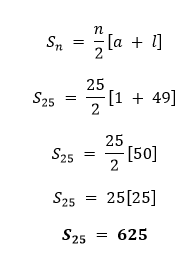
Hence, the sum of the odd numbers between 0 and 50 is 625. 15. A contract on construction job specifies a penalty for delay of completion beyond a certain date as follows: Rs 200 for the first day, Rs 250 for the second day, Rs 300 for the third day, etc., the penalty for each succeeding day being Rs 50 more than for the preceding day. How much money the contractor has to pay as penalty, if he has delayed the work by 30 days? Solution The penalty for the delay forms an AP: 200, 250, 300, … … First term = a = 200 Common Difference = d = 50 an = a + (n - 1)d n = 30 a30 = 200 + (30 - 1)(50) a30 = 200 + 29(50) a30 = 200 + 1450 a30 = 1650 Penalty for 30 days = S30 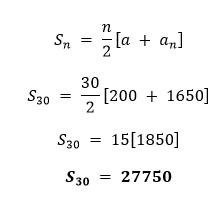
Hence, the contractor has to pay Rs 27750 penalty for a delay of 30 days. 16. A sum of Rs 700 is to be used to give seven cash prizes to students of a school for their overall academic performance. If each prize is Rs 20 less than its preceding prize, find the value of each of the prizes. Solution The values of each of the prizes can be represented as an AP: a, a - 20, a- 2(20), … …, a - 6(20) a, a - 20, a - 40, … …, a - 120 Sum of the given AP = S7 = 700 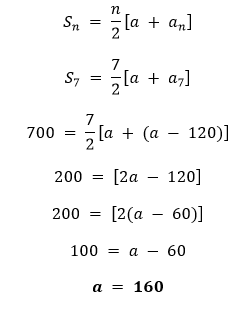
a1 = 160 a2 = 160 - 20 = 140 a3 = 140 - 20 = 120 a4 = 120 - 20 = 100 a5 = 100 - 20 = 80 a6 = 80 - 20 = 60 a7 = 60 - 20 = 40 Hence, the value of each of the seven prizes is Rs 160, Rs 140, Rs 120, Rs 100, Rs 80, Rs 60, Rs 40. 17. In a school, students thought of planting trees in and around the school to reduce air pollution. It was decided that the number of trees, that each section of each class will plant, will be the same as the class, in which they are studying, e.g., a section of Class I will plant 1 tree, a section of Class II will plant 2 trees and so on till Class XII. There are three sections of each class. How many trees will be planted by the students? Solution The number of trees planted by 3 sections of each class can be represented as an AP: 3 × 1, 3 × 2, 3 × 3, … …, 3 × 12 3, 6, 9, … …, 36 First term = a = 3 Common difference = d = 6 - 3 = 3 Last term = a12 = 36 Total number of trees planted by the students = S12 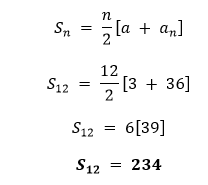
Hence, the total number of trees planted by the students is 234. 18. A spiral is made up of successive semicircles, with centres alternately at A and B, starting with centre at A, of radii 0.5 cm, 1.0 cm, 1.5 cm, 2.0 cm, . . . as shown in Fig. 5.4. What is the total length of such a spiral made up of thirteen consecutive semicircles? (Take π = 22/7). 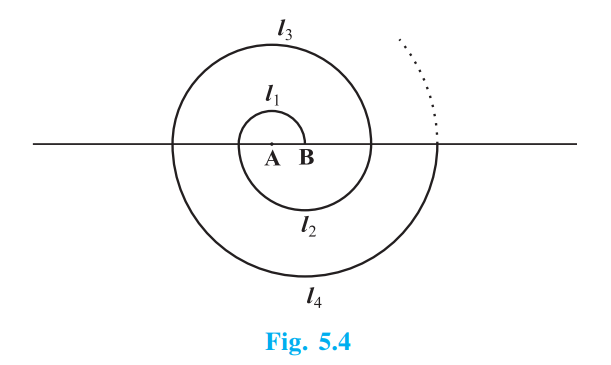
[Hint : Length of successive semicircles is l1, l2 , l3 , l4 , . . . with centres at A, B, A, B, . . ., respectively.] Solution Let the radii be denoted as R1, R2, R3, … …, R13. The radii of the semi-circles formed by the spiral are: 0.5, 1, 1.5, 2.0, … … The radii form an AP where, First term = a = 0.5 Common difference = 1 - 0.5 = 0.5 n = 13 Sum of all the radii = S13 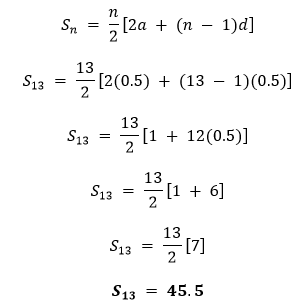
Length of the perimeter of a circle = 2πR Length of the perimeter of a semi-circle = 2πR/2 = πR Length of the given spiral = L = πR1 + πR2 + πR3 + … … + πR13 L = π(R1 + R2 + R3 + … … + R13) L = π(S13) L = (45.5)22/7 L = 143 Hence, the length of the given spiral is 143 cm. 19. 200 logs are stacked in the following manner: 20 logs in the bottom row, 19 in the next row, 18 in the row next to it and so on (see Fig. 5.5). In how many rows are the 200 logs placed and how many logs are in the top row? 
Solution Number of logs present in each row can be represented as an AP: 20, 19, 18, … … Logs in the first row = a = 20 Common difference = d = -1 Total number of logs = S = 200 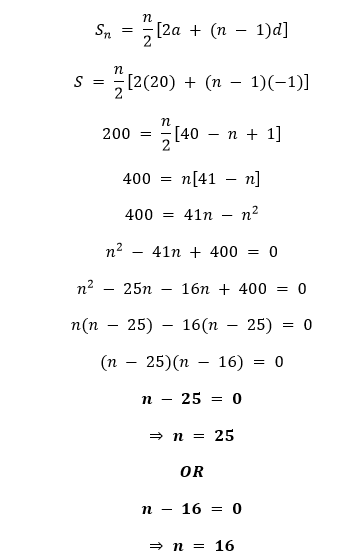
For n = 25, an = a + (25 - 1)d = 20 + 24(-1) = 20 - 24 = -4 But, it is not possible to have negative number of logs in the last row, so n = 25 is rejected. Therefore, n = 16. an = a + (16 - 1)d = 20 + 15(-1) = 20 - 15 = 5 Hence, the number of logs present in the top row is 5 and the number of rows is 16. 20. In a potato race, a bucket is placed at the starting point, which is 5 m from the first potato, and the other potatoes are placed 3 m apart in a straight line. There are ten potatoes in the line (see Fig. 5.6). 
A competitor starts from the bucket, picks up the nearest potato, runs back with it, drops it in the bucket, runs back to pick up the next potato, runs to the bucket to drop it in, and she continues in the same way until all the potatoes are in the bucket. What is the total distance the competitor has to run? [Hint : To pick up the first potato and the second potato, the total distance (in metres) run by a competitor is 2 × 5 + 2 × (5 + 3)] Solution Distance of first potato from bucket = 5m Distance of second potato from bucket = 5 + 3 = 8m Distance of third potato from bucket = 8 + 3 = 11m The distances of the potatoes from the bucket form an AP: 5, 8, 11, … … upto 10 terms First term = a = 5 Common difference = d = 3 The competitor has to run back to the bucket after picking up a potato. Therefore, the total distance covered = 2 × [Sum of distances of each potato from the bucket] = 2 × [S10] 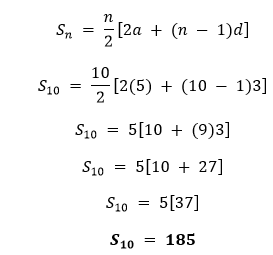
Total distance covered by the competitor = 2 × 185 = 370m. Exercise 5.4 (Optional)1. Which term of the AP : 121, 117, 113, . . ., is its first negative term? [Hint : Find n for an < 0] Solution First term = a = 121 Common difference = d = 117 - 121 = -4 Since, the required term is negative. Therefore, an < 0. 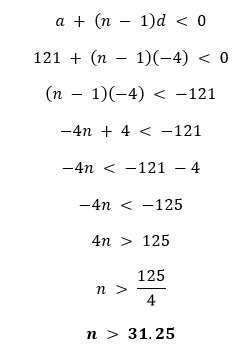
Hence, 32nd term of the given AP will be its first negative term. 2. The sum of the third and the seventh terms of an AP is 6 and their product is 8. Find the sum of first sixteen terms of the AP. Solution It is given that a3 + a7 = 6 and a3 × a7 = 8 a + 2d + a + 6d = 6 2a + 8d = 6 2(a + 4d) = 6 a + 4d = 3 = a5 a = 3 - 4d (a + 2d) (a + 6d) = 8 Use a = 3 - 4d (3 - 4d + 2d) (3 - 4d + 6d) = 8 (3 - 2d) (3 + 2d) = 8 32 - (2d)2 = 8 9 - 4d2 = 8 1 = 4d2 ¼ = d2 d = ± ½ Therefore, a = 3 - 4(± ½) a = 3 - 2 = 1 OR a = 3 + 2 = 5 CASE I: a = 1 and d = ½ 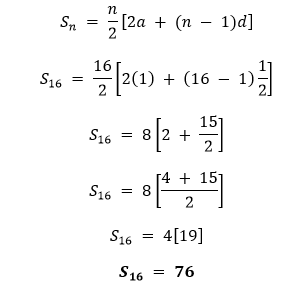
CASE II: a = 5 and d = -½ 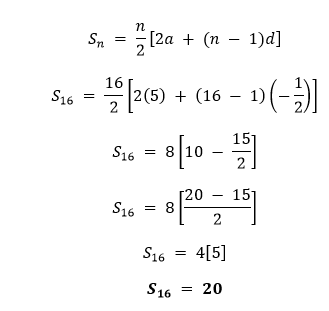
Hence, the sum of the first 16 terms of the given AP is either 76 or 20. 3. A ladder has rungs 25 cm apart. (see Fig. 5.7). The rungs decrease uniformly in length from 45 cm at the bottom to 25 cm at the top. If the top and the bottom rungs are
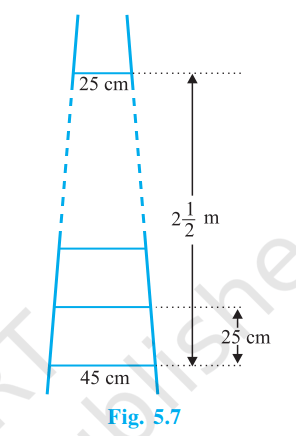
[Hint : Number of rungs = 250/25 + 1] Solution Each rung is 25 cm apart and the distance between first and last rung is 5/2 m = 250 cm apart. Therefore, number of rungs = 250/25 + 1 = 10 + 1 = 11 Since, the length of each of the rungs decreases uniformly, it will form an AP where First term = a = 45 Last term = a11 = 25 Length of wood required to make the rungs = Sn 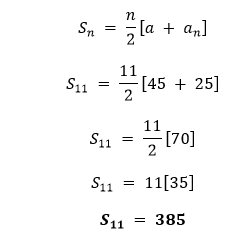
Hence, the total length of wood required to make the rungs is 385 cm. 4. The houses of a row are numbered consecutively from 1 to 49. Show that there is a value of x such that the sum of the numbers of the houses preceding the house numbered x is equal to the sum of the numbers of the houses following it. Find this value of x. [Hint : Sx - 1 = S49 - Sx ] Solution The house numbers form an AP: 1, 2, 3, … …, 49 First term = a = 1 Common difference = d = 1 Last term = a49 = 49 The sum of the numbers of houses that precede x = Sx - 1 The sum of the numbers of house that succeed x = S49 - Sx 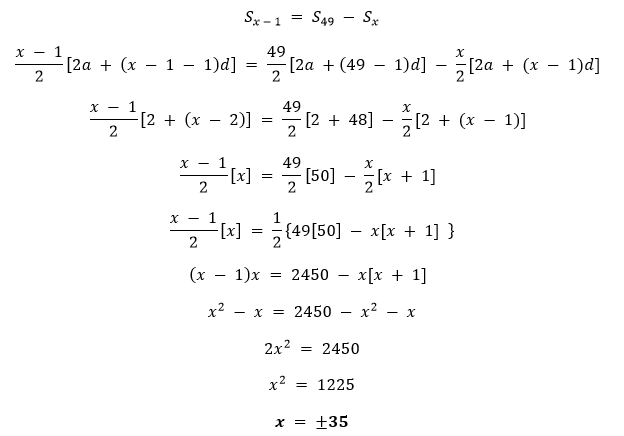
But, house number x has to be from 1 to 49, so x = -35 is rejected. Hence, x = 35. 5. A small terrace at a football ground comprises of 15 steps each of which is 50 m long and built of solid concrete. Each step has a rise of ¼ m and a tread of ½ m. (see Fig. 5.8). Calculate the total volume of concrete required to build the terrace. 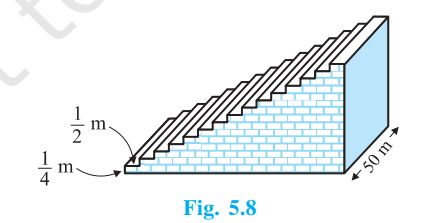
[Hint : Volume of concrete required to build the first step = ¼ × ½ × 50 m3] Solution The height of each step from the bottom increases by ¼ m, so it forms an AP: ¼, ¼ + ¼, ¼ + ¼ + ¼, … …, upto 15 terms ¼, ½, ¾, … … …, upto 15 terms First term = a = ¼ Common difference = d = ¼ Volume of concrete required for each step = Height × Tread × Width Tread = ½ m (fixed) Width = 50 m (fixed) Volume of concrete required to build the first step = ¼ × ½ × 50 m3 = a × ½ × 50 Volume of concrete required to build the second step = (¼ + ¼) × ½ × 50 m3 = a2 × ½ × 50 Therefore, total volume of concrete required for the terrace is = (a × ½ × 50) + (a2 × ½ × 50) + … … + (a15 × ½ × 50) = ½ × 50 × [a + a2 + … … + a15] = ½ × 50 × [S15] 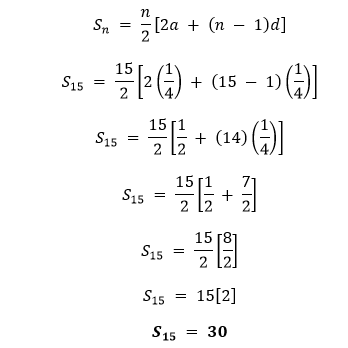
Total volume of concrete required = ½ × 50 × [30] = 750 m3 Hence, 750 m3 of concrete is required to make the terrace.
Next TopicClass 10 Chapter 6
|
 For Videos Join Our Youtube Channel: Join Now
For Videos Join Our Youtube Channel: Join Now
Feedback
- Send your Feedback to [email protected]
Help Others, Please Share




 = 19/2
= 19/2 + 14 + . . . + 84
+ 14 + . . . + 84 m apart, what is the length of the wood required for the rungs?
m apart, what is the length of the wood required for the rungs?




